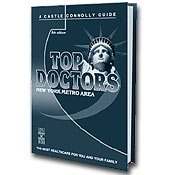Who picks the doctors?
A New York City research and information company called Castle Connolly Medical Ltd. publishes an annual guidebook, Top Doctors: New York Metro Area, which lists what it has determined to be the top 10 percent of the region’s physicians, more than 6,000 in all. For the past seven years, Castle Connolly has been providing New York Magazine with a shorter version of this list for the magazine’s “Best Doctors” issue (space prohibits New York from publishing the full list). These doctors—1,235 this year—represent the top 20 percent of the top 10 percent (that is, the top 2 percent) of New York–area physicians, as determined by Castle Connolly.
How does Castle Connolly decide which doctors are best?
The firm conducts a peer-review survey. The theory is that medical professionals are best qualified to judge medical professionals, and if one recommendation is good (think of your doctor referring you to a specialist), multiple recommendations are better.
To select the doctors, Castle Connolly sends out 12,000 nomination forms to medical professionals in New York City, Westchester County, Rockland County, Long Island, and portions of New Jersey and Connecticut. The recipients include randomly selected board-certified doctors; all doctors listed in the previous edition of Castle Connolly’s annual guidebook; and, from every hospital in the area, the president or CEO, the vice-president of medicine, and up to eight chiefs of service in departments from surgery to pediatrics.
The forms ask recipients to nominate those doctors who, in their judgment, are the best in their field and related fields—especially those to whom they would refer their own patients and family members (doctors can’t nominate themselves; nominations are kept confidential). Castle Connolly asks the nominators to take into account not only professional qualifications and reputation (education, residency, board certification, hospital appointment, and disciplinary record, for example) but also skills in dealing with patients (listening and communicating effectively, demonstrating empathy, instilling trust and confidence). The Castle Connolly staff then tabulates the results and vets the nominee pool, confirming the doctors’ board certification and licensing and investigating their disciplinary history.
Two important caveats: First, the list is adjusted for geographic balance. Because both the book and the list New York publishes are meant to help patients find doctors in their communities, Castle Connolly includes at least some top doctors from each relevant geographic area. On the one hand, this makes the list useful to the greatest possible number of New York Magazine readers; on the other hand, as a result of the concentration of excellent doctors in Manhattan, it forces some Manhattan doctors off the list.
Second, Castle Connolly strives for balance across specialties. Top doctors in popular specialties, therefore, might be left off in favor of a few in less-common fields. Keep in mind, though, that all the doctors listed, regardless of location or specialty, are included because they came highly recommended by their peers, and that all were screened by Castle Connolly’s rigorous checking process.
Does New York check out all the doctors on the list?
The magazine’s fact-checkers independently verify every doctor’s name, phone number, hospital affiliation, special expertise, and insurance guidelines, but it would be impossible to “check out” each doctor with an office visit. That said, there are usually a handful of cases every year in which Castle Connolly and the magazine decide to omit a doctor from the list when circumstances like pending litigation are brought to their attention.
My doctor says he was left out last year because of politics. Could that be true?
To the extent that politics can enter into any peer-review process, it is possible that a given nominator had concerns other than a candid assessment of his peers’ skills when filling out his ballot. But Castle Connolly doesn’t play favorites in its selection process, and the large number of nominators tends to correct for any individual’s possible political motives.
If my doctor’s not on the list, does that mean she’s not a great doctor?
No. The selection of doctors by peer review—and the compilation of a list that considers diversity of specialties and geography—inevitably leaves out many outstanding doctors.
Don’t the same doctors get nominated every year?
Many doctors do, but there are many new doctors on the list each year, too. Because established, well-known doctors are exactly that—established and well known—the list may favor that kind of physician. That may mean fewer new choices each year, but it also means the list is inherently conservative. Given the importance of choosing a doctor, Castle Connolly and New York view that as a healthy bias.
My wife’s doctor was on last year’s list and isn’t on this year’s. What does that mean?
It doesn’t necessarily mean anything; it certainly shouldn’t be taken as evidence of a drop-off in the doctor’s effectiveness. Getting on the list once doesn’t guarantee a doctor a “lock” on a position; the selection process begins anew every year.
You feature profiles of certain doctors in the issue. Some are on the “Best Doctors” list; others aren’t. Why?
To make the “Best Doctors” issue more readable, New York—and not Castle Connolly—selects a number of doctors to highlight in greater detail. This year, for instance, the magazine focuses on thirteen innovators—pioneers in fields from oncology to orthopedics to radiology. All of them are doing compelling, cutting-edge work that’s advancing their field. That some have been selected by their peers as being among the area’s top doctors and others have not is a separate issue.
How can I see the full list of 6,000-plus doctors?
The next edition of Castle Connolly’s guide will be published this month. Visit castleconnolly.com for additional information.
